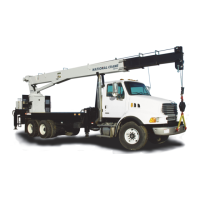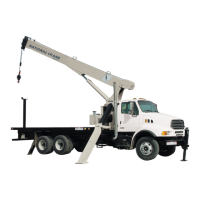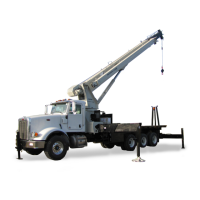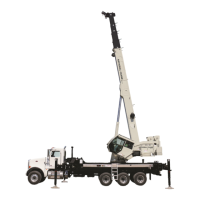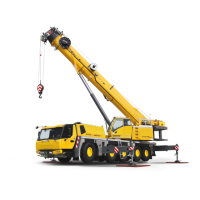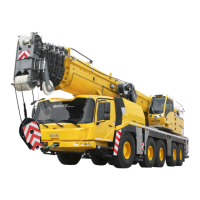2-18
+ !x!
The dual hydraulic capacity alert system should be
checked for proper adjustment during initial crane start
up and quarterly thereafter. The procedure for proper
adjustment should be performed as follows:
3$&9'%4$&$&+)%'
$))$6^x5j;'$&+x
$4$&$$}!~
!6+%('$6$.
1. Set the HCA Selector Switch to BOOM if
installed.
2. Remove the frame or console back cover de
pending on crane model.
Before loosening any fittings, support the boom.
3. Start the truck and set the crane up for operation
as prescribed in the Safety and Operation
Section.
4. Ensure the Dual Hydraulic Capacity Selector
Switch is properly set.
5. Select a test weight that is equal to crane capacity
at an intermediate boom length and radius. Work
with loads which have load boom angles near 30°.
Starting with the boom at the chosen reference
angle and a radius less than the chosen radius,
pick the weight up with the winch and begin
extending the boom.
a. As the boom is extending, lower the
load with the winch to keep the load near
the ground.
b. Monitor the load range gauge located in
the console as the boom is extending.
The gauge is plumbed directly into the lift cyl-
inder pilot line and the pressure reading should
increase to what is defined as capacity load
pressure as the selected intermediate boom
length and radius is reached.
The intermediate boom length is determined
by a line and corresponding dimension decal
on the side of the second section boom. The
chosen radius is measured from the centerline
of rotation to the load line.
c. If the gauge reading does not increase
while extending, lower the load to the
ground and check the system plumbing
according to the hydraulic schematic. Re-
"
!
plumb the system according to the sche-
matic and illustrated parts page or replace
faulty pressure gauge.
Before loosening any fittings, support the
boom.
6. When the pressure reaches capacity load pres
sure, the overload system should activate and
boom extension will stop. This is defined as trip
pressure.
7. Trip pressure should be reached as the boom
extension reaches the chosen radius. If the over
load system trips before the chosen radius is
reached or allows extension beyond the chosen
radius, adjustment is required.
a. If the system is activated before trip
pressure is reached, lower the load,
loosen the locking nut on the compensat-
ing pressure switch and turn the switch
head clockwise to increase trip pressure.
NOTE
Pressure switch trip pressure is very sensitive
to the number of turns on the switch head.
Turning the switch one-fourth turn changes
the switch trip pressure by approximately 500
psi.
8. When the system reaches trip pressure, turn the
switch head counterclockwise until the system
solenoid is deactivated and tighten the locking nut.
a. Retract the boom until the pilot pressure
is reduced enough to reactivate the
system solenoid. The hydraulic capacity
alert indicator light will go out when the
solenoid is reactivated.
b. Check the trip pressure setting by
extending the load until the chosen radius
is reached. As the chosen radius is
reached, the system solenoid should be
deactivated and the indicator light should
come on.
c. Readjust switch head if trip pressure is
not correct.
9. Once proper adjustment is verified, return the
boom to a firmly supported position, stop the
truck engine and replace covers.
"
!
Reference Only
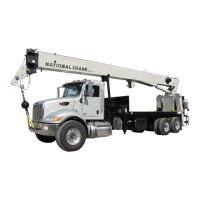
